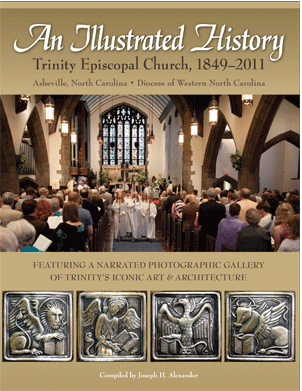Asheville, North Carolina
EXPLORE FAITH. EMBRACE COMMUNITY. MAKE A DIFFERENCE.
60 Church Street, Asheville, NC 28801 | info@trinityasheville.org | Tel: 828-253-9361

OUR HISTORY
Three pioneer women, led by Henrietta Kerr Patton, became the catalyst for the founding of Asheville’s first Episcopal church. The women accosted Bishop Levi Ives as he rode through town on a long circuit from Raleigh, beseeching him to establish an Episcopal mission in the mountain village. Impressed by their fervor, Ives directed the Reverend Jarvis Buxton of St. James in Rutherfordton to commence monthly services in Asheville. Buxton cheerfully saddled his horse and rode 40 miles through the mountains to Asheville. On Sunday, August 1, 1847, he preached his first service to a modest but joyful gathering.
The seed took root. In 1849 Buxton moved his family to Asheville and became rector of the newly founded Trinity Episcopal Church, a calling he served faithfully for the next 42 years.

The Reverend Jarvis Buxton (w/ cane) greeting parishioners at the first church.
Soon, the fledgling parish needed its own church. Henrietta Patton persuaded her husband James to give Trinity the rectangular woodlot he owned west of the village, bordered by the intersection of two footpaths that would later become Church and Aston Streets. The congregation raised enough money to build a small, brick-walled structure and had enough left over to buy a brass bell for the steeple.
The vestry replaced the original church with a larger structure in the 1880s. Unfortunately, a raging fire destroyed the lovely new church on November 15, 1910. Only the marble baptismal font survived.

The Second Church from Lexington Avenue
While the grieving congregation worshipped in small rooms about town, the vestry selected New York architect Bertram Grosvenor Goodhue to design the third Trinity in classic Gothic Revival style. Construction lagged, but in June 1913, the parish celebrated the opening service in its inspiring new structure, highlighted by its sharply pitched slate roof, corner bell tower, and soaring chestnut trusses, and destined in time for the National Register of Historic Places.
Even so, the worth of a church lies less in its architecture than in the hearts of its people. Trinity’s enduring legacy for 160 years has been its commitment to outreach ministries in the community. Following the Civil War, Henrietta Patton’s son Thomas donated ten acres of land in northeast Asheville where Trinity members built a chapel as a place of worship for African-Americans, including recently emancipated slaves. In 1896 the black congregation built St. Matthias Episcopal Church on the chapel site.
Inspired by Jarvis Buxton’s missionary zeal, other Trinity volunteers provided lay readers and teachers to establish mission churches in outlying communities. Other Trinity parishioners helped found Mission Hospital and Asheville’s first public library.
In 1969 Trinity hosted the Asheville-Buncombe Community Christian Ministry’s first exchange of clothing and food in the church’s undercroft. Since 1998 Trinity has provided its undercroft as the home for the Church of the Advocate, an outreach mission for the city’s homeless population established by the Diocese of Western North Carolina.
Teams of Trinity’s amateur carpenters have helped Habitat for Humanity build more than a dozen new homes for local partner families, including eight “Episcopal Houses” constructed in tandem with the other churches of the Asheville Deanery.
In 1991, concerned about Asheville’s lack of a juvenile retention center, the parish purchased a nearby residence, converted it with volunteer labor into a state-

The Second Church from Church Street - c.1880s–1910
certified group shelter, and then leased it for a $1 a year to a licensed care-giving agency. Since then, Trinity Place has provided safety, shelter, and professional counseling for thousands of the city’s troubled, runaway teenagers.
More recently, small groups of parishioners have set out from Trinity to rebuild hurricane-damaged homes in Mississippi, construct affordable homes in Guatemala, and deliver goats as sustainable nutrition for an isolated Haitian village.
Today, Henrietta Kerr Patton’s portrait greets approaching Trinity worshipers with a welcoming yet watchful expression — perhaps to ensure the newest generation continues to offer a helping hand in the journey of faith within the community and the world at large.

To obtain a copy of An Illustrated History, Trinity Episcopal Church, 1849–2011 please contact the church office at 828-253-9361. The cost is $50.
